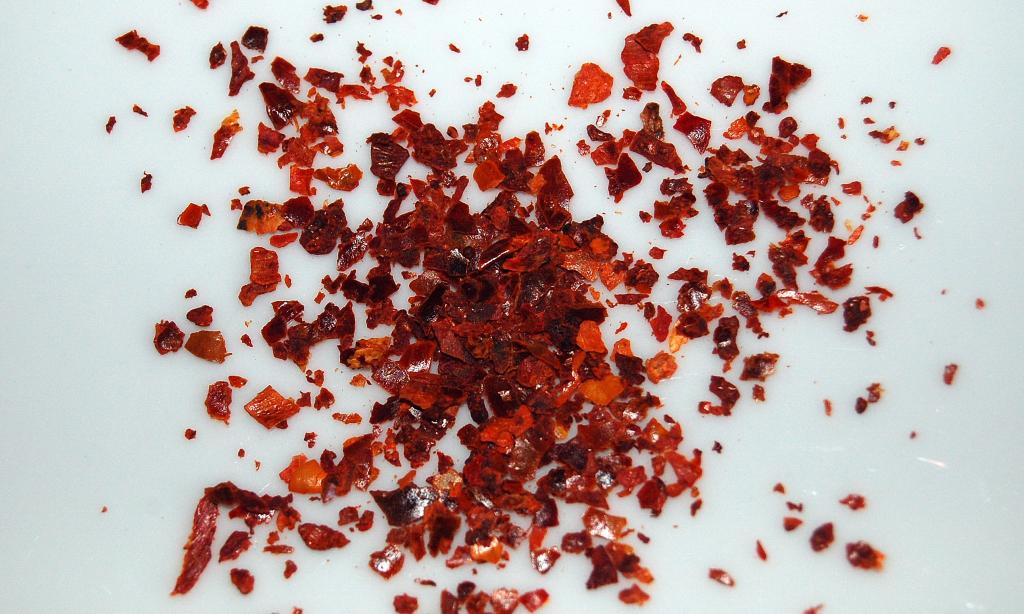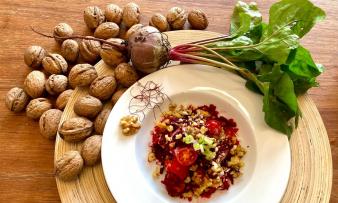Table of contents
Chili flakes are chopped, coarsely ground chili peppers that you can use to spice up many different dishes. Depending on how they are produced, the flakes can be raw. Make sure they are organic quality.
Use in the kitchen
What are chili flakes? Chili flakes are made from crushed, dried chili peppers. Like chili powder, they are versatile and are mainly used in Italian, Mexican and Asian cuisine. The flakes are based on typically hot varieties such as cayenne, jalapeño or serrano. In addition to being an essential ingredient in chili sauces and chili pastes, they are often used to season and spice up vegan pasta dishes, pizzas, stews (such as raw, oil-free chili sin carne with tomatoes or with mushrooms and wild garlic), curries, goulash, ragouts, soups or as a topping for raw salads. The amount of chili flakes depends on how hot you want your dish to be. Chili flakes harmonize excellently with garlic and ginger, provide a pleasant spiciness in fruity chutneys made from mangoes or apples and also offer an interesting taste experience as a contrast in sweet desserts. Whether in combination with fruit (e.g. strawberries), as part of exotic chocolate or together with nuts (e.g. macadamia nuts) and honey as a snack between meals.
If you want to make chili oil, you can put a tablespoon of the chili flakes together with 250 ml of oil of your choice (e.g. cold-pressed rapeseed oil) in a glass container, close it well and let it steep for a few days.
Are chili flakes raw? As long as the drying process of the pods does not exceed a temperature of 42 °C (either by sun or machine), you can call chili flakes raw. Since this information is difficult to obtain with ready-made products, it is often easier to make the flakes yourself if you want them in raw food quality. Organic quality is preferable.
Homemade preparation
Can you make your own chili flakes? You can make your own chili flakes in just a few steps. Thin-walled chili varieties are best, such as de Arbol, Cayenne or the particularly hot Habanero.
Note: The spiciness of chili flakes is due to the presence of the alkaloid "capsaicin". This secondary plant substance is found mainly in the placenta, the seed pod walls and, in slightly smaller quantities, in the seeds of the pod and cannot be washed off the hands with water. Once you have worked with hot chili varieties, you should rub your hands with vegetable oil or clean them with high-proof alcohol to deactivate the capsaicin. Alternatively, you can put on plastic gloves when preparing the food.
To make your own chili flakes, follow the steps below:
- Wash raw chilies, pat dry, remove the stem and cut into rings. Use gloves when preparing them or wash your hands thoroughly with vegetable oil or high-proof alcohol after cutting.
- Place the pieces on a baking tray and dry in the oven (convection) or dehydrator. You can read detailed instructions for this under the ingredient chili peppers, sun-dried. This process can take several hours. It is best to open the kitchen window.
- The drying process takes about 5 - 6 hours. When opening the oven, allow the irritating fumes to dissipate before removing the baking tray.
- Grind dried chili pieces in a blender or mortar until flakes form that are about the size of the seeds.
Then store the flakes in an airtight screw-top jar or spice shaker.
Vegan recipe for raw vegetable salad with chili flakes
Ingredients (for 4 people): 2 red bell peppers, 1 fennel, 1 cucumber, 1 avocado, ½ onion, 1 garlic clove, 1 tbsp chili flakes (organic), 1 tbsp rapeseed oil (cold pressed), 1 tbsp lemon juice, salt andpepper (to taste).
Preparation: Wash the bell pepper, fennel and cucumber and cut into small pieces. Halve the avocado, remove the pit and cut the flesh into cubes. Peel the onion and garlic clove and chop finely. Mix the chili flakes, rapeseed oil, lemon juice, salt and pepper in a small bowl. Mix all ingredients together in a large bowl and season with the chili sauce. Arrange the vegan raw food salad on four plates and enjoy.
Vegan recipes with chili flakes (raw) can be found under the note: " Recipes that have the most of this ingredient ".
| Not only vegans or vegetarians should read this: Vegans often eat unhealthily. Avoidable nutritional errors. |
Purchasing - Storage
Chili flakes are available all year round in well-stocked supermarkets such as Coop, Migros, Spar, Aldi, Lidl, Rewe, Edeka, Hofer, Billa and in organic quality in organic supermarkets such as Denn's Biomarkt and Alnatura. Other good places to go are delicatessens, Asian shops or online retailers. The spice may be available at smaller supermarket chains such as Denner and Volg during selected promotions.
There are chili flake products that are deliberately processed without seeds or kernels to give them a piquant but not very hot taste. Others contain the seeds and are therefore much hotter.
The availability of chili flakes varies depending on the size of the store, catchment area, etc. Our recorded food prices for the DA-CH countries can be found above under the ingredient image - and by clicking you can see their development at various suppliers.
Storage tips
Store red chili flakes in a dark, dry and cool place or use dark glass jars with lids or sealable spice jars for storage.
Ingredients - Nutritional values - Calories
Here we realistically show you the ingredients of spices and herbs per 1 g (instead of per 100 g as usual).
1 g of chili flakes provides 3.24 kcal of energy. This includes 0.06 g of fat, 0.7 g of carbohydrates (of which 0.41 g of sugar) and 0.11 g of protein. 1
Vitamin A, vitamin K and potassium are the most important essential nutrients that chili flakes offer. However, because the amount consumed is so small, they and the macronutrients do not contribute significantly to meeting the daily requirement. Far more important for the health value are the secondary plant substances in this ingredient, which can have an effect even in trace amounts. Although all herbs and spices have many health-promoting ingredients, we deliberately avoid the insubstantial buzzword "superfood" here.
Chilies are rich in secondary plant substances that have antioxidant and antidiabetic effects. These include phenolic compounds, carotenoids, flavonoids and capsaicinoids - the substances that cause spiciness. 2
The complete ingredients of chili flakes (raw), the coverage of the daily requirement and comparison values with other ingredients can be found in our nutrient tables. In the article Nutrients explained you will get a detailed insight into the topic.
Health effects
Are chili flakes healthy? The health benefits of chili flakes are mainly due to the secondary plant substances they contain, such as capsaicin. This belongs to the group of capsaicinoids, which have an antibacterial and fungicidal effect. 3
Researchers have extensively studied the biological effects of capsaicin. In addition to cardioprotective, antilithogenic (kidney stone prevention), heat-generating, anti-inflammatory and pain-relieving properties, it also has positive effects on the gastrointestinal system. Capsaicinoids therefore have potential clinical value for pain relief, cancer prevention and weight loss. 4 However, it should be noted that many of the results come from animal experiments that require further clinical studies. You can find detailed information in the article on cayenne pepper.
Dried red chili peppers and chili flakes made from them are also rich in carotenoids. The pigments responsible for the red color, capsanthin, capsorubin and lutein, have an antioxidant effect and can protect against UV light. 5
Dangers - Intolerances - Side effects
Higher doses of capsaicin can lead to mucous membrane irritation, nausea, vomiting or high blood pressure. Children in particular should be careful, as they can suffer serious poisoning more quickly. However, according to the German Federal Institute for Risk Assessment, no health disadvantages are to be expected within the scope of internationally usual consumption. This applies to a maximum intake of 5 mg capsaicin per kg body weight. For a person weighing 60 kg, this would be 300 mg capsaicin per meal. 6
People with a rare allergy to nightshade plants can have an allergic reaction or intolerance when eating chili flakes. The allergy spectrum is very individual and can change over time. 7 It is also possible for cross-allergies to develop, e.g. from existing allergies to birch pollen, grass pollen, cereal pollen or mugwort pollen. 7,8
Dried chilies and chili flakes have a high proportion of omega-6 fatty acids (LA) and a low proportion of omega-3 fatty acids (ALA). 1 The Western diet is characterized by a high proportion of omega-6 and a low proportion of omega-3 fatty acids. 9 Too much omega-6 fatty acids and a very high omega-6/omega-3 ratio promote the development of numerous diseases such as cardiovascular diseases, cancer, and inflammatory and autoimmune diseases. Omega-3 fatty acids, on the other hand, counteract these developments. 10 However, consuming chili flakes in small quantities is harmless.
Ecological footprint - animal welfare
The ecological footprint of a food depends on various factors. The type of agricultural production (conventional vs. organic), seasonal, regional or domestic production or import by truck, ship or plane, different types of packaging and whether the goods are fresh or frozen all play a decisive role. 11
The CO 2 footprint of chili flakes is difficult to find, here we show values for unprocessed, fresh chilis in the range of: 0.4 to 0.85 kg CO 2 eq/kg, which can vary depending on the producer and country of production. 12 The processing of fresh spices, such as basil, also has a very low CO 2 footprint at 0.33 kg CO 2 eq/kg, dried basil shows a significantly higher value at 7.34 kg CO 2 eq/kg. 13
The amount of water required to produce 1 kg of dried chilies is 7365 l/kg. 17 The following applies: Fresh, unpackaged, seasonal and regional vegetables have the lowest emissions. The more a product is processed, the higher its environmental impact is as a rule.
Detailed explanations of various sustainability indicators (such as ecological footprint, CO2 footprint, water footprint) can be found here.
Worldwide occurrence - cultivation
Information on the worldwide occurrence and cultivation of chili peppers can be found directly in the article on the ingredient chili peppers, red. Chili flakes are now available worldwide. Increasing interest in spicy, aromatic food and Mexican, Thai or Indian cuisine, increasing knowledge about the health benefits of chili flakes and the increased use in the growing market for ready-made products are leading to a high demand for the spicy flakes. 14
Industrial production
The production of chili flakes is essentially similar to that of chili powder : after harvesting, the fruits are cleaned, dried and then ground to the desired degree of fineness, in this case into coarse flakes. An Australian study on the production of chili spice shows that drying whole fruits is very time-consuming (up to 6 days) and that significantly less time and energy is needed if you dry chopped chili peppers. At temperatures above 60 °C, the chilies in the hot air dryer turned a brown and therefore inferior color. Special heat pump dryers were used to dry the chopped chilies at 40 °C and a very satisfactory result was achieved with dark red chilies - in raw food quality. Depending on how much moisture remains, drying takes more than 48 hours. 18
Further information
Chili flakes are made from the numerous chili varieties of the Capsicum genus of the nightshade family (Solanaceae). There are currently 35 wild and 5 domesticated species ( Capsicum annuum, C. frutescens, C. chinense, C. baccatum and C. pubescens). 15
The spiciness of the Capsicum genus is measured in so-called Scoville units. The classification on the Scoville scale depends on the capsaicin it contains. The spiciness is generally divided into mild (0-700 Scoville units), spicy (700-3000 Scoville units, e.g. sambal-Tabasco sauce), medium hot (3000-25,000 Scoville units, e.g. jalapeño), hot (25,000-70,000 Scoville units, e.g. serrano or cayenne pepper) and very hot (over 80,000 Scoville units, e.g. habanero). Pure capsaicin has a value of 15-16 million Scoville units. However, there are types of pepper, such as the chili hybrid "Carolina Reaper", whose Scoville units even break the 2 million mark. 16
Unlike humans and other mammals, birds do not perceive capsaicinoids as spicy. This is due to a different structure of their nerve cells. Unlike mammals, birds do not grind the seeds, travel longer distances and thus contribute to the more effective spread of the plants. 3
Alternative names
In English, chili flakes are called "chili flakes", "crushed red pepper" or "red pepper flakes". Incorrect spellings such as "chilifloken" or "chilli flakes" can occur.











Comments